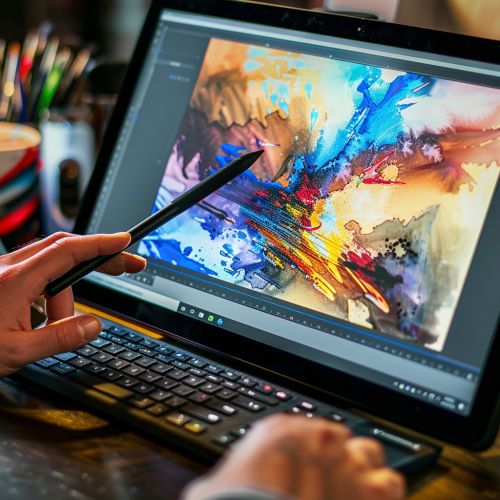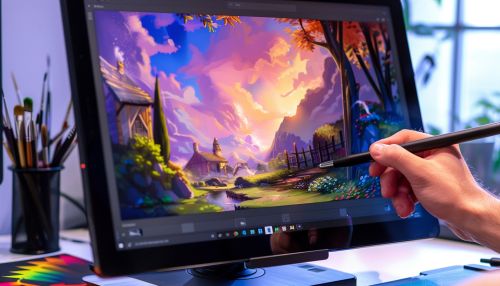Digital Art Techniques: Difference between revisions
(Created page with "== Introduction == Digital art techniques encompass a wide range of methods and tools used to create artwork digitally. These techniques have evolved significantly with advancements in technology, providing artists with new ways to express their creativity. This article explores various digital art techniques, tools, and applications, offering a comprehensive overview for both novice and experienced digital artists. == Historical Context == The origins of digital art ca...") |
No edit summary |
||
| Line 28: | Line 28: | ||
Vector art is created using mathematical equations to define shapes and lines. This technique is often used for creating logos, icons, and illustrations that need to be scalable without losing quality. Software like [[Adobe Illustrator|Illustrator]] is commonly used for vector art. | Vector art is created using mathematical equations to define shapes and lines. This technique is often used for creating logos, icons, and illustrations that need to be scalable without losing quality. Software like [[Adobe Illustrator|Illustrator]] is commonly used for vector art. | ||
[[Image:Detail-96107.jpg|thumb|center|An artist using a graphics tablet and stylus to create digital art on a computer screen.|class=only_on_mobile]] | |||
[[Image:Detail-96108.jpg|thumb|center|An artist using a graphics tablet and stylus to create digital art on a computer screen.|class=only_on_desktop]] | |||
=== 3D Modeling === | === 3D Modeling === | ||
Latest revision as of 05:57, 4 July 2024
Introduction
Digital art techniques encompass a wide range of methods and tools used to create artwork digitally. These techniques have evolved significantly with advancements in technology, providing artists with new ways to express their creativity. This article explores various digital art techniques, tools, and applications, offering a comprehensive overview for both novice and experienced digital artists.
Historical Context
The origins of digital art can be traced back to the 1950s and 1960s when early computer graphics were developed. Artists began experimenting with computers to create visual art, leading to the emergence of computer art. The development of software like Photoshop and hardware such as graphics tablets revolutionized the field, making digital art more accessible and versatile.
Tools and Software
Digital art relies heavily on specialized tools and software. Some of the most widely used tools include:
Graphics Tablets
Graphics tablets, such as those produced by Wacom, allow artists to draw directly onto a digital surface with a stylus. These devices offer precision and control, mimicking the experience of traditional drawing.
Software
Several software programs are essential for digital artists:
- **Adobe Photoshop**: A versatile tool for photo editing, painting, and illustration.
- **Corel Painter**: Known for its realistic brush strokes and textures.
- **Procreate**: A popular app for digital painting on iPads.
- **Blender**: A powerful open-source software for 3D modeling and animation.
Techniques
Digital art techniques vary widely, depending on the medium and style. Some of the most common techniques include:
Digital Painting
Digital painting involves using software to create artwork that resembles traditional painting. Artists use various brushes and tools to apply color and texture to a digital canvas. Techniques such as layering, blending, and masking are commonly used to achieve depth and detail.
Vector Art
Vector art is created using mathematical equations to define shapes and lines. This technique is often used for creating logos, icons, and illustrations that need to be scalable without losing quality. Software like Illustrator is commonly used for vector art.


3D Modeling
3D modeling involves creating three-dimensional objects using specialized software. Artists can sculpt, texture, and animate models for use in video games, films, and virtual reality. Programs like Blender and Maya are popular choices for 3D modeling.
Photo Manipulation
Photo manipulation involves altering photographs to create surreal or enhanced images. Techniques include retouching, compositing, and applying filters. Photoshop is a widely used tool for photo manipulation.
Applications
Digital art techniques are applied in various fields, including:
Entertainment
In the entertainment industry, digital art is used for creating visual effects, animations, and concept art for films, television, and video games. Artists work closely with directors and designers to bring imaginative worlds to life.
Advertising
Digital art plays a crucial role in advertising, where it is used to create eye-catching visuals for campaigns. Techniques such as photo manipulation and vector art are commonly employed to produce compelling advertisements.
Education
Digital art is also used in educational materials, including textbooks, e-learning courses, and interactive applications. Illustrations, diagrams, and animations help convey complex concepts in an engaging manner.
Challenges and Considerations
While digital art offers numerous advantages, it also presents challenges. Artists must stay updated with rapidly evolving technology and software. Additionally, the digital medium can sometimes lack the tactile feedback of traditional art, requiring artists to adapt their techniques.
Future Trends
The future of digital art is likely to be shaped by advancements in artificial intelligence, virtual reality, and augmented reality. These technologies have the potential to revolutionize how artists create and interact with their work, offering new possibilities for creativity and expression.
